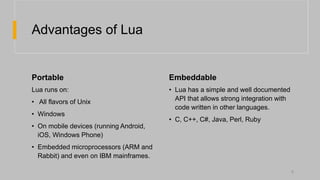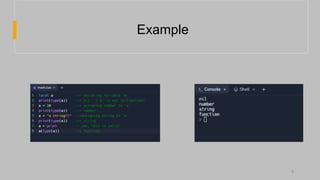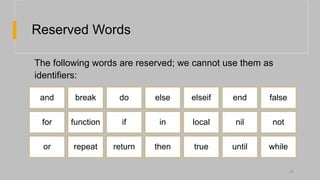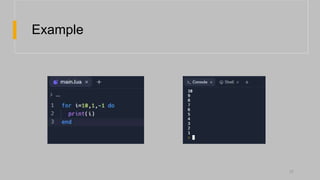Lua Programming Language.pptx
- 2. Agenda • Introduction to Lua • Data Types in Lua • Reserved Words & Variables • Operators • Control Statements • Functions 2
- 3. Introduction to Lua What is Lua and why to use Lua?
- 4. What is Lua? • Lua is a powerful, efficient, lightweight, embeddable scripting language. It supports procedural programming, OOP, functional programming, data driven programming etc. 4 4
- 5. Advantages of Lua Powerful Fast • Lua is a very beginner friendly language and is easy to implement. • Lua is not a pure object-oriented language, yet it provide meta-mechanisms for implementing classes and other OOP concepts. • Lua has a safe environment, automatic memory management, and good facilities for handling strings and other kinds of data with dynamic size. • Lua has a deserved reputation for performance. • To claim to be ‘as fast as Lua’ is an aspiration of other scripting languages. 5
- 6. Advantages of Lua Portable Embeddable Lua runs on: • All flavors of Unix • Windows • On mobile devices (running Android, iOS, Windows Phone) • Embedded microprocessors (ARM and Rabbit) and even on IBM mainframes. • Lua has a simple and well documented API that allows strong integration with code written in other languages. • C, C++, C#, Java, Perl, Ruby 6
- 7. Data Types in Lua Data types available in Lua
- 8. Data Types • Lua is a dynamically typed language. • There are no type definitions in the language; each value carries its own type. • Values can be stored in variables, passed as a parameter or return the results. • Lua has eight basic types are: nil, Boolean, number, string, userdata, function, thread and table. 8
- 9. Example 9
- 10. Data Types in Lua nil as a kind of non-value, to represent the absence of a useful value (equivalent to false in conditional expressions). nil The Boolean type has two values, false and true. Boolean The number type represents real (double-precision floating-point) numbers. Number Strings have the usual meaning: a sequence of characters. String The table type implements associative arrays, the index of the array can be a number or a string. Tables Functions can be stored in variables, passed as arguments to other functions, and returned as results. Functions 10
- 11. Tables • The table type implements associative arrays. • An associative array is an array that can be indexed not only with numbers, but also with strings or any other value of the language, except nil. • Moreover, tables have no fixed size; you can add as many elements as you want to a table dynamically. • Also, you can assign nil to a table field to delete it. 11
- 12. Tables • To create a table a table constructor expression is used. • In its simplest form it is written as {}. • To access elements of a table [] is used. 12
- 13. Nested Tables • It is possible to implement nested tables in Lua. • To do so simply assign tables as the elements of another table. • To access the tables inside tables [][] is used. 13
- 14. Example 14
- 15. Table Manipulation • Insertion and removal of items in tables is most common in table manipulation. 15 Inserts a value into the table at specified position. table.insert (table, pos, value) Removes the value from the table. table.remove (table , pos)
- 16. Example 16
- 17. Reserved Words & Variables Variable naming and reserved words
- 18. Variable names or Identifiers Identifiers in Lua can be any string of letters, digits, and underscores, not beginning with a digit or other special characters; for instance: i player MAX_health _ij aVeryLongname _INPUT 18
- 19. Global Variables • Global variables do not need declarations. You simply assign a value to a global variable to create it. • It is not an error to access a non-initialized variable; you just get the special value nil as the result. 19
- 20. Global Variables • Usually, you do not need to delete global variables; if your variable is going to have a short life, you should use a local variable. • But, if you need to delete a global variable, just assign nil to it. • After that, it is as if the variable had never been used. In other words, a global variable is existent if (and only if) it has a non-nil value. 20
- 21. Local Variables • Besides global variables, Lua supports local variables. We create local variables with the local statement: 21
- 22. Local Variables • Unlike global variables, local variables have their scope limited to the block where they are declared. • A block is the body of a control structure, the body of a function, or a chunk (the file or string with the code where the variable is declared). 22
- 23. Example 23
- 24. Reserved Words 24 and break do else elseif end false for function if in local nil not or repeat return then true until while The following words are reserved; we cannot use them as identifiers:
- 26. Arithmetic Operators Consider A=10, B=20: 26
- 27. Relational Operators Consider A=10, B=20: 27
- 28. Example 28
- 29. Logical Operators Consider A = a week has 7 days. B = February month can have 31 days. 29
- 30. Example 30
- 32. Control Structures • Lua provides a small and conventional set of control structures, with if for conditional and while and for for iteration. • All control structures have an explicit terminator: end terminates the if, for and while structures. 32
- 33. if then else • An if statement tests its condition and executes its then-part or its else-part accordingly. The else-part is optional. 33
- 34. elseif • When you write nested ifs, you can use elseif. It is similar to an else followed by an if, but it avoids the need for multiple ends: 34
- 35. while • As usual, Lua first tests the while condition; if the condition is false, then the loop ends; otherwise, Lua executes the body of the loop and repeats the process. 35
- 36. Numeric for • The for statement has two variants: the numeric for and the generic for. • A numeric for has the following syntax: • That loop will execute something for each value of var from exp1 to exp2, using exp3 as the step to increment var. This third expression is optional; when absent, Lua assumes one as the step value. 36 for var=exp1,exp2,exp3 do something end
- 37. Example 37
- 38. Generic for • The generic for in Lua allows us to iterate over the values in an iterator fashion; it is much more powerful even though it looks simple. • The Lua library has plenty of iterators, over which we can use the generic for loop. 38
- 39. Generic for • Its syntax is: • The i in the above syntax denotes the index of the items we are going to iterate over only by one, and the v denotes the actual values of those items. The x is the iterable item over which we are iterating, it can be a table, list, array, or map. 39 for i, v in pairs(x) do ... ... end
- 40. Example 40
- 41. Functions Syntax and use of Functions
- 42. Functions • Syntax of functions in Lua is: • In the syntax, a function definition has a name, a list of parameters, and a body, which is a list of statements. function function_name (parameters) .. .. end 42
- 43. Example 43
- 44. Multiple Results • Functions written in Lua also can return multiple results, by listing them all after the return keyword. 44
Editor's Notes
- #2: ID=d924773e-9a16-4d6d-9803-8cb819e99682 Recipe=text_billboard Type=TextOnly Variant=0 FamilyID=AccentBoxWalbaum_Zero











![Tables
• To create a table a table constructor expression is used.
• In its simplest form it is written as {}.
• To access elements of a table [] is used.
12](https://image.slidesharecdn.com/luaprogramminglanguage-230108082610-03f2c7d2/85/Lua-Programming-Language-pptx-12-320.jpg)
![Nested Tables
• It is possible to implement nested tables in Lua.
• To do so simply assign tables as the elements of another
table.
• To access the tables inside tables [][] is used.
13](https://image.slidesharecdn.com/luaprogramminglanguage-230108082610-03f2c7d2/85/Lua-Programming-Language-pptx-13-320.jpg)






























